Artists’ Forum
-That Space Between Light and Dark-
A Performance Featuring Roko Kawai and her Friends
- Sept. 17 (Sat) 2005. 5:00pm – (Doors opens at 4:30 pm )
at Youkobo Art Space Performers:
Roko Kawai + Hideo Arai (dance),
Christopher Yohmei + Mika Kimula (music) - *Admission free but space is limited to 30 persons and reservations are requested: Internatioal House of Japan (Tel: 03-3470-3211) Sponsored by the International House of Japan with support from Youkobo Art Space.Youkobo ART SPACE
- Phone: 03(5930) 5009 Fax: 03(3399) 7549
- URL: http://www.youkobo.co.jp
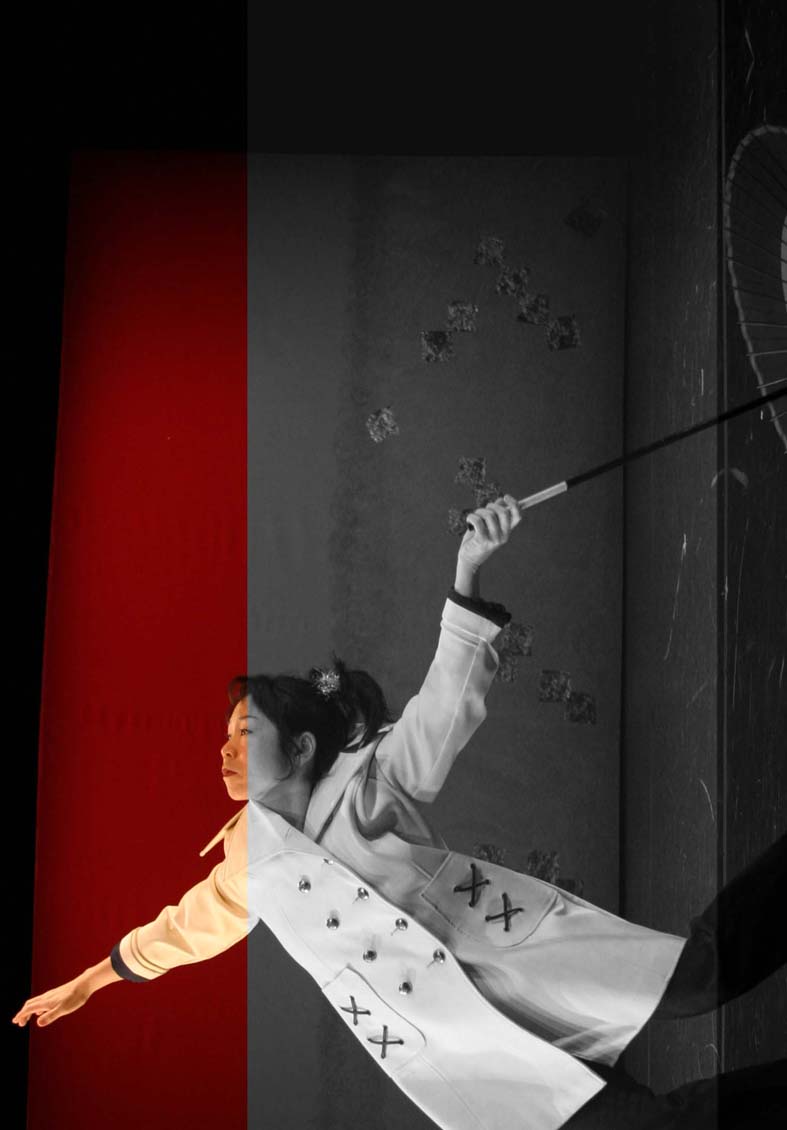 As daylight fades into the gloaming, the doors and windows of an old clinic remade into art gallery are opened to allow both the audience and performers to freely cross the space between shifts of light, the outside and inside, movement and sound, and incidental occurrances. Come and share with us those moments between light and dark, day and night, as one season ends and another begins.
As daylight fades into the gloaming, the doors and windows of an old clinic remade into art gallery are opened to allow both the audience and performers to freely cross the space between shifts of light, the outside and inside, movement and sound, and incidental occurrances. Come and share with us those moments between light and dark, day and night, as one season ends and another begins.
Roko Kawai Profile
ROKO KAWAI is a Philadelphia-based independent dancer/choreographer who is investigating the relationship between the specificity of traditional dance and the craft of improvisation. In 2000, she returned to her earlier study of Japanese Classical Dance and has since focused her exploration on its physicality, musicality and theatricality as inspiration for post-modern improvisation and choreography. Her international work includes The Art of RiceTraveling Theater through UCLA’s Center for Intercultural Performance in Bali and a collaboration in New Zealand with light designer Helen Todd. Her earlier work was presented throughout Philadelphia including at DanceBoom! Festival; Movement Research Exchange and Symphony Space in New York; Northwestern University in Chicago; at the Florida Dance Festival and Jacob’s Pillow Inside/Out. Roko has been supported by the Artists Exploration Fund of Arts International, Dance Advance, Independence Foundation, the PA Council on the Arts, DanceLINK, and others. In 2003, Roko was awarded The Pew Fellowship in the Arts for Choreography. She is currently in Tokyo on the Japan-U.S. Friendship Commission Fellowship, researching the connections and collisions between Japanese classical and contemporary dance.
Artists’ Forum/ Solo exhibition
LUIS RECODER
STILL FILM
- June 2 (Thur.) – June 13 (Mon.), 2005
12:00 – 20:00 (last day closes at 17:00) - Closed on Tuesdays Opening Reception: June 2, 18:00- This exhibition is co-sponsored by Youkobo Art Space and the International House of Japan Artists’ Forum with assistance from the Tokyo American Center.Youkobo ART SPACE
Zempukuji, 3-2-10, Suginami, Tokyo, 167-0041, JAPAN - Phone: 03(5930) 5009 Fax: 03(3399) 7549
- URL: http://www.youkobo.co.jp
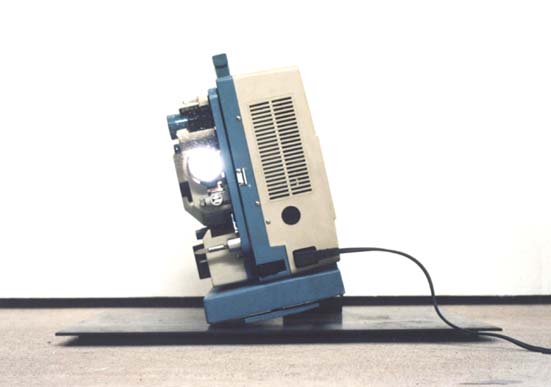 Artist’s Statement
Artist’s Statement
STILL FILM is a work of projected film light. It is as much about light on a screen as it is about the frame which contains it and the dark space surrounding it: the space that envelopes the viewer. -Luis Recoder
The Exhibition
The International House of Japan, together with Youkobo Art Space, will co-produce a solo exhibition by Luis Recoder, entitled STILL FILM. Unlike most film artists, Recoder does not use a camera to shoot footage to create a film. Instead, he works with the rudimentary tools of the cinema: the projector, the screen, and the space of projection itself. Extending the work of minimalist artists who work with light and space, such as James Turrell, Recoder reorients the viewer’s attention towards pure light and color in a manner that calls to mind John Cage’s proposed definition of art: that of “paying attention.” In an age when images are becoming increasingly digitalized, Recoder is a contemporary artist who makes us rethink the origins of the image itself.
Critique
Luis Recoder’s current work extends his investigation of cinema’s alternate pleasures -the fundamental ones of light, movement, space, and time. He continues his attempts to reorient us in relation to cinema through a process of reduction, allowing for a celebration of the essence of consciousness while at the same time fulfilling a cultural need to experience a sense of grounded, physical connection to the world.
Holly Willis, editor of Res magazine
I am interested in the particular light cast by the cinema of film. This light is better articulated in the wake of the so-called digital divide. The flood of conical light of diverse kinds allows us to experience film as if for the first time. There is no nostalgia for film. No disavowal for the new cinemas. There is instead a ‘giving back’ to film what is inherently its own, which left by itself is in danger of losing this innermost insight. We are not in an epoch of a ‘rediscovery’ of film but the first witnesses of its coming into being in the nearness of its death.
Luis Recoder Profile
Born 1971San Francisco, CA
Education
1999 MFA San Francisco Art Institute, CA
1995 BFA University of California at Berkeley
Awards &Fellowships
2005 Japan-United States Friendship Commission, National Endowment for the Arts
2004 The James D Phelan Art Award
Commission, National Endowment for the Arts
2004 The James D Phelan Art Award
Selected Screenings & Exhibitions
2004 “2004 Whitney Biennial” Whitney Museum of American Art, NY
2003 32nd International Film Festival Rotterdam, The Netherlands
2002 “2002 Whitney Biennial” Whitney Museum of American Art, NY
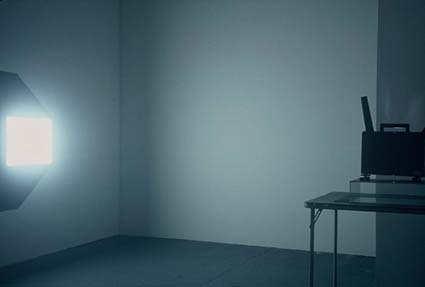 Recoder is a filmmaker who works not in the traditional sense with film and documentation of subject matter but with the basic materials of film projection: the interplay between light and screen. He is in Japan for six months on the Japan-US Creative Artists’ Exchange Program to observe and develop an approach to incorporate an interdisciplinary and cross-cultural practice between modern and ancient cultural rites. Residing in Tokyo, Recoder is inspired by the 20th century phenomenon of the benshi and the ancient rock gardens of Kyoto.
Recoder is a filmmaker who works not in the traditional sense with film and documentation of subject matter but with the basic materials of film projection: the interplay between light and screen. He is in Japan for six months on the Japan-US Creative Artists’ Exchange Program to observe and develop an approach to incorporate an interdisciplinary and cross-cultural practice between modern and ancient cultural rites. Residing in Tokyo, Recoder is inspired by the 20th century phenomenon of the benshi and the ancient rock gardens of Kyoto.
Artists’ Forum
kodakan: Pinoys sa Japan
– A photo-essay of Filipinos in Japan
- Tuesday, March 22, 2005
7 pm (Doors open at 6:30 pm) at Lecture Hall
A reading by R. Zamora Linmark from My Tokyo Notebook, a work-in-progress detailing his experiences, and the lives of Filipinos, in Japan. With photos by Shinya Ochida.
R. Zamora Linmark
Born in Manila and educated in Honolulu, R. Zamora Linmark is the author of Rolling The R’s (Kaya Press) and Prime Time Apparitions, a poetry collection forthcoming from Hanging Loose Press. He is the recipient of a National Endowment for the Arts and two Fulbright grants to the Philippines. He is currently living in Tokyo, on a U.S.-Japan Friendship Commission grant, where he is at work on a documentary and an experimental notebook detailing his experiences in Japan as a Filipino American artist.
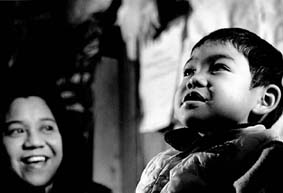 |
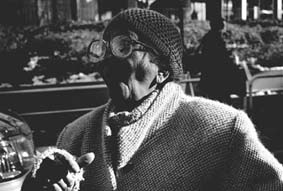 |
Artists’ Forum
AN OLFACTORY HAPPENING
in a collaborative performance
based on scent and the sense of smell……
- Wednesday, December 22, 2004 7:00 PM
- Lecture Hall, THE INTERNATIONAL HOUSE OF JAPAN
Supported by the Japan US Friendship Commission Collaborative Projects Grant
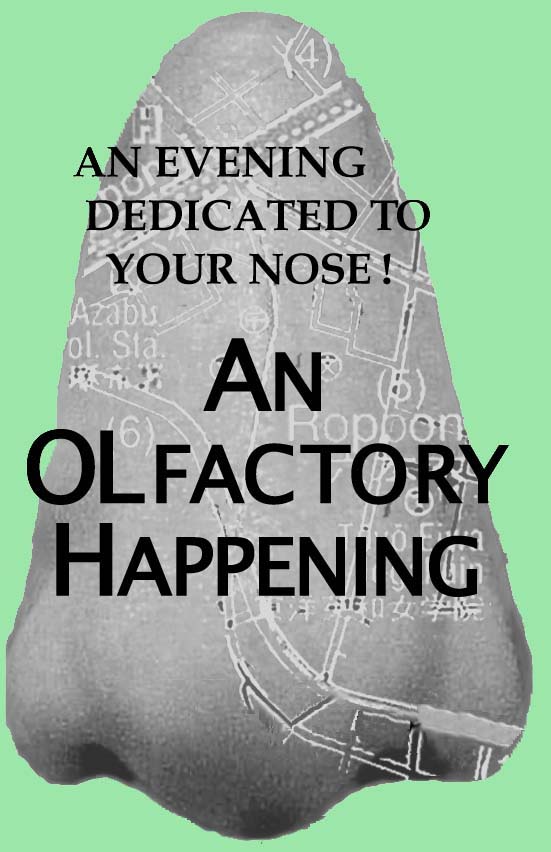 |
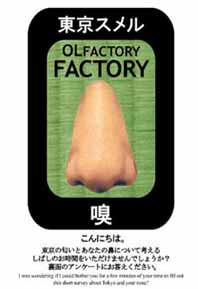 |
Laure Drogoul is a sculptor and performance artist presently in Japan on a US-Japan Creative Artists’ fellowship.Her work incorporates video, performance, audience participation and explores the relationship between biology, popular culture and myth. In Japan, she is working on a public art project called “OlfactoryFactory,” collecting and mapping the smells of Tokyo with a mailing survey and her rolling “scentorium” (a cart specially designed to collect smells). With these tools and your imput, she will create a “smellscape” of Tokyo to be presented in a collaborative performance at the I-House. Come to the performance and see, hear and smell the results. What is the quintessential odor of Tokyo?
Collaborator Profiles:
Naoko Maeshiba (choreographer/ butoh dancer)
Naoko’s work draws from both Asian and Western dance/theatre forms. She performs multi-disciplinary works throughout the world. Her work ranges from site-specific improvisational pieces in collaboration with musicians and visual artists to tightly choreographed, complete theater pieces.
Mami Takahashi (painter)
Using traditional Japanese pigments, Mami works along spiritual themes with paper, mixed media and printing techniques. She recently opened her own studio in Tokyo where she teaches Japanese Art and painting utilizing gold leaf, powder, washi paper, watercolor and basic sketching.
Audrey Chen (cello, voice)
Audrey mixes cello and self-styled vocal techniques and has emerged as a vital, free-improvising musician from the US. Her approach to improvisation and performance is instinctive, and she utilizes traditional and extended technique in order to create a hybrid language that pushes musical boundaries.
Catherine Pancake (percussion, inventions)
Catherine performs improvised music in collaboration with various local and international musicians. Her current projects explore the outer limits of free jazz and extreme sound through dry ice manipulation and free form improvisation: aptly referred to as “freak out” music.
- “OlfactoryFactory” website can be viewed at http://www.olfactoryfactory.org http://www.olfactoryfactory.org
IHJ Artists’ Forum
HOMAGE TO ISADORA DUNCAN
Performance and Talk
- Date: December 3 (Fri), 2004, 7.30 pm – (Foyer open at 7pm ,doors open at 7:20pm)
- Venue: International House of Japan, Lecture Hall
- Admission: Free / Reservations required. Fully booked.
- Language: English (with Japanese translation)
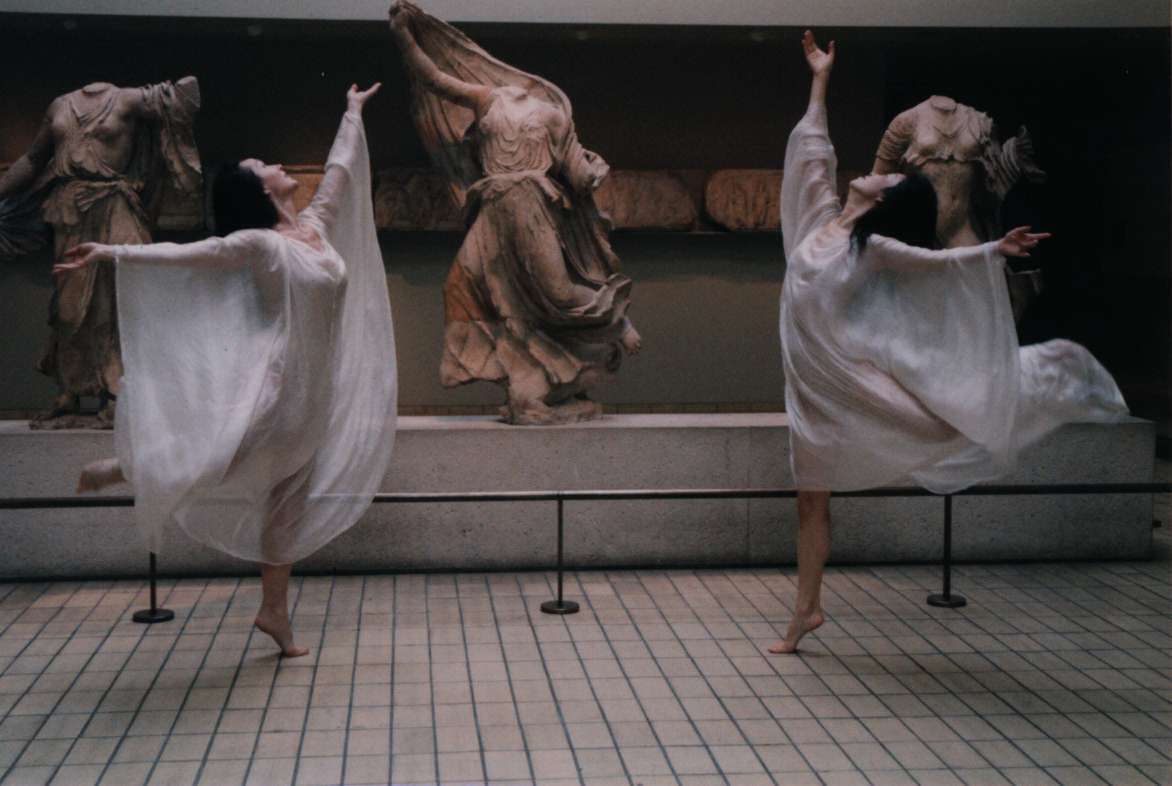 Photo: Mika Temma
Photo: Mika TemmaThe year 2004 marks the 100th anniversary of American dancer Isadora Duncan’s Modern Dance Education. She established the first school in Germany in 1904, where she taught children for free. Success of this school inspired Duncan and her pupils to establish dance schools throughout Europe and America as well. Due to their efforts, modern dance became a new and viable dance form around the world. At the IHJ Artists’ Forum, Dr. Jeanne Bresciani, the artistic director of Isadora Duncan International Institute and the Institute’s ambassador to Japan, Ms. Michiyo Sato, will present several reconstructed dance works choreographed by Isadora Duncan in honor of Isadora and creation of Modern Dance Education.
Profile:
Jeanne Bresciani M.A., M.A., I.M.A., Ph.D.
- Artistic Director, Isadora Duncan International Institute (http://www.isadoraduncaninternationalinstitute.org) Bresciani, a former Kress and Fulbright Scholar, received a Bachelor of Arts from Skidmore College, a Master of Arts in the History of Art from Williams College, and a Master of Arts and Doctor of Philosophy in Dance from New York University. She is the founding director of ‘Isadora for Children’ and ‘Isadora for Adults’ Programs based at The Harkness Dance Center in New York, and she teaches at New York University, throughout the US and abroad. Bresciani holds an I.M.A. degree in Movement Analysis and Imaginal Psychotherapy: a program directed by Debra McCall and inspired by the work of James Hillman.
Michiyo Sato M.A., M.A., I.M.A., Ph.D.
Isadora Duncan International Institute, Ambassador to Japan Sato received a Bachelor of Arts from Tsuda College in International and Cultural Studies. As a former Rotary Foundation scholar, Sato received a Master of Dance Education degree from NYU along with the Dr. Patricia Rowe Award for “Outstanding Commitment to Dance Education.” she teaches as a certified Duncan Dance teacher, and has just presented her works Silk and Ume Blossoming: to the Women of Japan at New York Joyce SoHo.
IHJ Garden Concert
Shared Visions—Music of the Americas and Japan
- Date: September 22, 2004, (Wed.), 7pm
(Doors open at 6:30) - Venue: International House of Japan Garden
(held indoors in the event of rain map ) - Admission: 3,000 yen (Discounted Rate), 4,000 yen (Regular Rate)
- This program is supported by the US-Japan Friendship Commission Artists’ Collaborative Project Grant
- Musicians:
Composition, Guitar: Ray Sandoval (Recipient, US-Japan Creative Artist Exchange Fellowship)
Piano: Chiharu Kuroki
Bass: Tetsuya Mashine
Percussion: Tomoyuki Yamada / Kenji Matsuura
Special guest musician: Hozan Yamamoto (Shakuhachi, Living National Treasure)Special thanks to MUSIC CAMP, Inc.
Photo: Kenjun Kawawata
IHJ Artists’ Forum
IHJ Artsists’ Forum WADAIKO WORKSHOP Michael Naishtut INTERNATIONAL WADAIKO GROUP AKAONI-DAIKO
- March 2 (Tue), 2004, 6 – 9 PM
Special Reception Room, The International House of Japan - Admission Free/ Reservations required. Workshop participants limited to 25 persons. Non-participant observers also welcome.
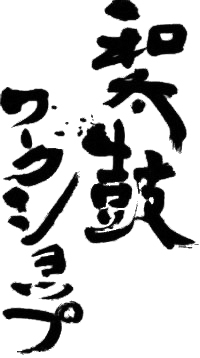
 Michael Naishtut, leader of the International Taiko drum Group, Akaoni Daiko, will lead a taiko workshop for the IHJ Artists’ Forum. The workshop is open to anyone regardless of experience and will cover basic body positioning, arm/body movement, proper grip, striking techniques and basic rhythms. The workshop will end with the students performing a simple piece.
Michael Naishtut, leader of the International Taiko drum Group, Akaoni Daiko, will lead a taiko workshop for the IHJ Artists’ Forum. The workshop is open to anyone regardless of experience and will cover basic body positioning, arm/body movement, proper grip, striking techniques and basic rhythms. The workshop will end with the students performing a simple piece.
IHJ Artists’ Forum
Yoshiko Chuma, Presentation/Performance
VIEWING DANCE AS ART: 1976-2003.
THE NEWS FROM NEW YORK
- Date: December 22, 2003 (Mon), 2003, 7:00 pm
- Venue: Lecture Hall at International House of Japan
Admission Free / Reservations required
 |
 |
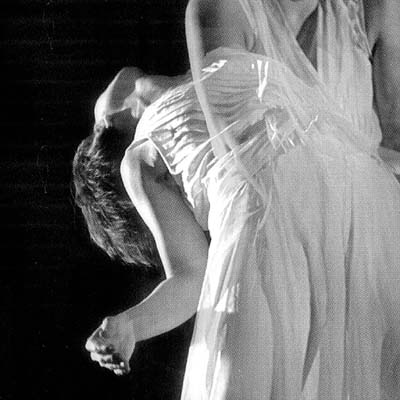 |
 |
Yoshiko Chuma (artistic director, choreographer) is a native of Japan who moved to the United States in 1976. She founded The School of Hard Knocks in New York in 1980 and serves as its Artistic Director. The School of Hard Knocks is an award-winning collaborative effort of choreographers, dancers, musicians, actors, singers, designers and visual artists. The company takes its name from the American idiom meaning, “learning the hard way.” In twenty two years of performance history, the company has lived up to its name by challenging every aspect and definition of the contemporary performing arts. Over 1000 people from around the world have been a part of The School of Hard Knocks “pipeline,” appearing in more than forty-five original, mostly site-specific works, created by the company and performed in formal theaters, streets and in intimate living rooms throughout the US, Asia and Europe. For the IHJ Artist Forum, Chuma will talk about her dance experience and the unusual company she directs. The talk will be illustrated with videos and live performance, joined by The School of Hard Knocks dancers Eiji Sato and Nobuko Higuchi.
IHJ Artists’ Forum
Quilt Artists Ellen Oppenheimer & Yoko Ueda
Present a Cross-Cultural Collaboration of Spirit and Technique
- Date: November 25, 2003 (Tue), 2003, 19:00
Quilt Display: Nov. 21 (Fri) to Dec.1 (Mon). (IHJ Reception Desk)
Admission Free / Reservations required (phone or E-mail)
In English (with Japanese translation)
Venue: The International House of Japan Lecture Hall
Ellen Oppenhiemer is one of America’s most innovative contemporary quiltmakers who uses the most advanced dyeing and silkscreen techniques to create fine geometric patterns on her work. Presently in Japan on a six month US-Japan Creative Artists’ Exchange grant, she resides in Kyoto where she investigates Japanese dyeing and other traditional craft techniques. In September, Ellen began a collaboration with the internationally known and respected Japanese quilt maker, Yoko Ueda. Using the theme of “water,” the two of them will produce two quilts, each 150cm X 150 cm. First, they will use their own dyeing techniques to create an unfinished, base quilt. Then they will exchange the cloth and utilize such techniques as marbling, stencil and printing to work both separately and together to create the finished quilts. Oppenheimer and Ueda come from two different cultural and linguistic backgrounds. Although they utilize some similar techniques in their work process, the finished products reflect their differences in aesthetics and approach. This collaboration will highlight both differences and similarities, fused into two separate quilts. At the Artists’ Forum, the artists will talk about their work and techniques. You may view the finished quilts on display in the IHJ lobby until the afternoon of Monday, December 1.
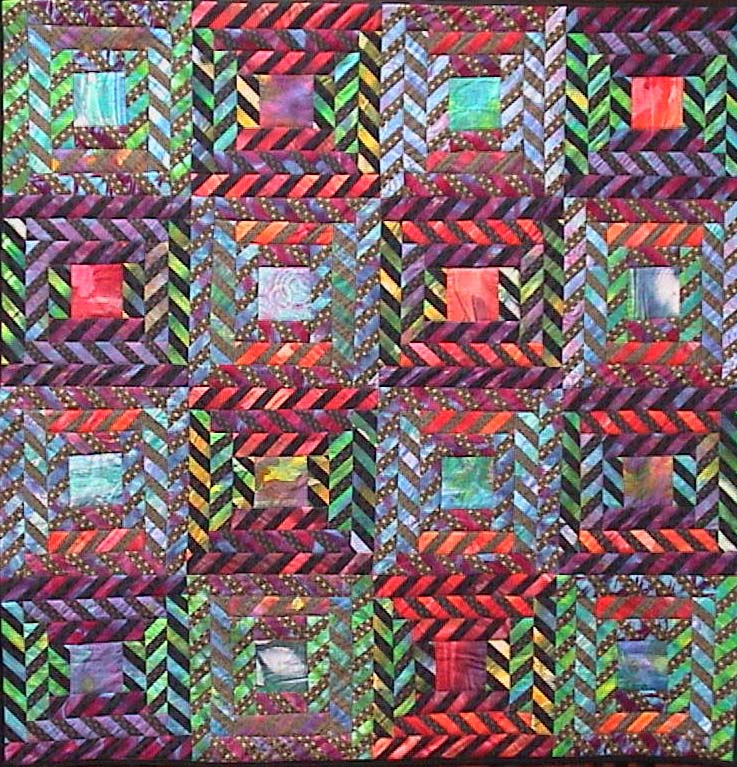 |
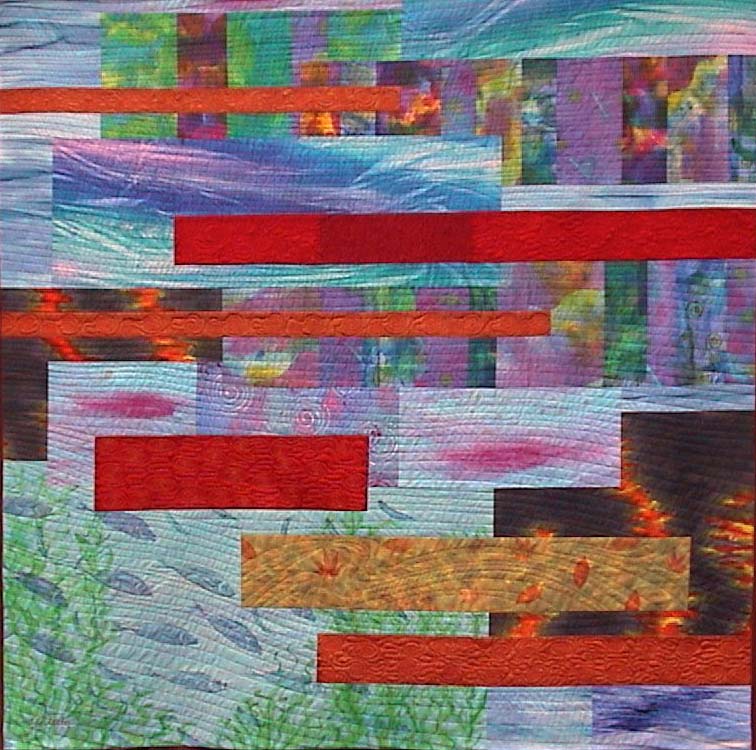 |
Photo1) Ellen Oppenheimer Quilt
Photo2)Yoko Ueda Quilt
IHJ Artists’ Forum
REMY CHARLIP’S BODY PLAY & INTERNAL DANCING
A hands-on “playshop” for heightening awareness of the physical body and its movements
- Date: Sept, 30 2003 (Tue) 19:00
Admission Free / Reservation Requested
Venue: International House of Japan, Lecture Hall
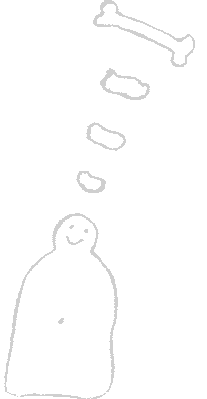 This is a rare opportunity to work in a master class with Remy Charlip. Remy, who was in Japan in 1988 on a Japan-US Creative Artists’ Grant, is a dancer, choreographer, children’s book writer and illustrator. He has spent years perfecting body awareness, movement technique and connecting the various aspects of his life. In this “playshop,” Remy will lead us to discover how to relate to ourselves, our thoughts, our feelings and our actions. He will show us how to re-direct our own internal energy, and how by “non-doing,” change our ingrained bodily habits. Remy incorporates many body awareness and healing projects in his work: the Alexander technique, Eurythmy, psychic healing, bone mediations, jin shin jutsu, humor, sign language of deaf people, al-anon, and chi gong. This workshop is for musicians, dancers, actors, artists, house-husbands, writers, body working, craft people and teachers-in other words, anyone who wants to use their body expressively, create easeful movement and find the freedom important for any endeavor we undertake. Please wear loose clothing. Bring musical instruments, paper & pencil, scripts, songs, brushes, computers, dance phrases, etc., so you can renegotiate a new relationship with them. Private sessions will also be available if so desired.
This is a rare opportunity to work in a master class with Remy Charlip. Remy, who was in Japan in 1988 on a Japan-US Creative Artists’ Grant, is a dancer, choreographer, children’s book writer and illustrator. He has spent years perfecting body awareness, movement technique and connecting the various aspects of his life. In this “playshop,” Remy will lead us to discover how to relate to ourselves, our thoughts, our feelings and our actions. He will show us how to re-direct our own internal energy, and how by “non-doing,” change our ingrained bodily habits. Remy incorporates many body awareness and healing projects in his work: the Alexander technique, Eurythmy, psychic healing, bone mediations, jin shin jutsu, humor, sign language of deaf people, al-anon, and chi gong. This workshop is for musicians, dancers, actors, artists, house-husbands, writers, body working, craft people and teachers-in other words, anyone who wants to use their body expressively, create easeful movement and find the freedom important for any endeavor we undertake. Please wear loose clothing. Bring musical instruments, paper & pencil, scripts, songs, brushes, computers, dance phrases, etc., so you can renegotiate a new relationship with them. Private sessions will also be available if so desired.
IHJ Artists’ Forum
HANDS: Rhythm Project
A Collaboration of Multicultural Drumming, Dance and Music
 |
- Norihiko Akagi: Percussion, Tohen Hibiki: Wadaiko,. Habib Khan: Sarangi, alguja, morchang Indian folk instruments, Atsuko Kida: Koto¤juushichigen, Kohinoor Langa: Kartal Indian folk percussion instrument, Takashi Sakai: Computer, Kentaro Uchida: Bass, Christopher Yohmei: Shakuhachi
- Date: June 6, 2003 (Fri) 19:00
Admission: 3,500 yen (Discount Rate: 3,000 yen)
Venue: International House of Japan Garden (held indoors in the event of rain)
This program is supported by US-Japan Friendship Commission Artists’ Collaborative Project Grant and the Tokyo American Center.
As part of the US-Japan Friendship Commission Artists’ Collaborative Project, Nandlal Nayak, Wendy Jehlen and a variety of Japanese, American and Indian artists will present a multicultural collaboration of drumming, music and dance. Japanese musicians include some of the leading percussionists of both western and Japanese drumming, 13 and 17 string koto, shakuhachi, electric bass and computer manipulation. As special guests, two world-renowned Rajastani folk musicians will travel to Japan for this project. HANDS: Rhythm Project brings together musicians and instruments both traditional and contemporary; folk and classical musical styles. The music is heavily percussive and draws on the strength of the wadaiko drums, Nayak’s Indian folk dholak, West African drums, the intensity of the Rajastani kartal and the South American cajon drum. To this is added the fascinating and endless rhythmic variations of electronic percussion and various folktales of Japan interpreted through the electronic bass and koto. Melodies from Japan and Rajasthan played on the shakuhachi, sarangi and flute are woven into this musical fabric.
US-Japan Friendship Commission Artists’ Collaboration Project
Performance Artists’ Forum Performance:
UMI YO UMI YO!
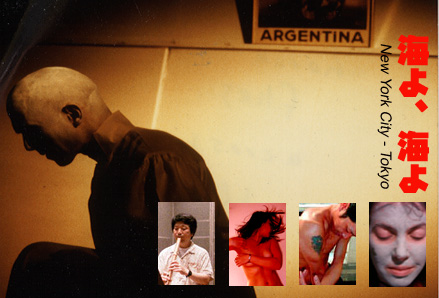 |
- Yoshito Ono, Perry Yung, Kinya Sogawa, Laurie Sogawa, Maura Donohue
- Guest Performers: Kazuo Ono, Nandlal Nayak, Anabel Cameron-Lewis, Keiko Hashimoto, Motoko Sasaki, Hideyo Nozawa, Michiyuki Kato, Anika Z. Nayak, Wendy Jehlen, Shoko Ishikawa, Birgit Binder, Tokuhiko Akagi, Yuki Takahashi, Toshio Mizohata (Lighting)
Date: April 5, 2003 (Sat) 15:00 Start
Admission: 3,000 yen (including Drink)
Venue: Kazuo Ohno Dance Studio 1-20-15 Kamihoshikawa, Hodogaya, Yokohama.
For reservation and information: 070-5570-6942
IHJ Artists’ Forum
Perry Yung & Maura Donohue Performance and Talk
As an extension of the collaboration project, Perry Yung and Maura Donohue will present an evening of experimental performances with modern dance, butoh dance, and shakuhachi in the intimate setting of the International House of Japan.
- Guest Artists: Kinya Sogawa, Laurie Sogawa and others
- Date: April 10, 2003 (Thu) 19:00
Admission Free / Reservation Requested
Venue: International House of Japan, Lecture Hall
Youkobo Art Space & IHJ Artists’ Forum Presents
Elizabeth Mead: Photography & Sculpture
Mute Observation
- Date: March 6, 2003 (Thursday)-17 (Monday) 11:00-19:00
(Final Day Closed at 17:00 / Closed on Tuesdays)
Opening Reception: March 619:00-21:00 - Venue: Youkoubo Art Space 3-2-10 Zenpukuji, Suginami-ku, Tokyo 167-0041
Map: http://www.youkobo.co.jp/
This exhibition is co-sponsored by Artists’ Forum, The International House of Japan, Inc.
Contact: Youkobo Art Space Tel: 03-5930-5009
The exhibition “Mute Observation” (Kotoba no kyokaisen no mukogawa kara), sculptures and photographs by Elizabeth Mead, 6 to 17 March at the Youkobo Art Space in Suginami-ku seeks to foster cultural exchange between the US and Japan. The two cultures view themselves through an outside lens, each seeing the other through opposing eyes. The work presented–sculptures and photographs–explores the cultural differences between the two countries. Western observation of Japanese notions of space, as witnessed for example through architecture, depict the interchange and dialogue between western and eastern experiences of dwelling. The aim of this exhibition is to foster greater awareness of the differing cultures of Japan and the US and also to point to similarities. It is an opportunity for each culture to see itself through the eyes of the other.
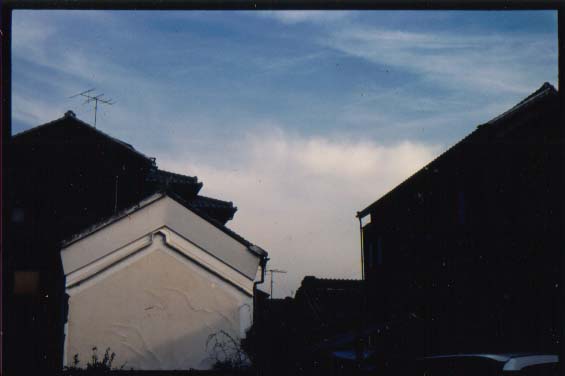 |
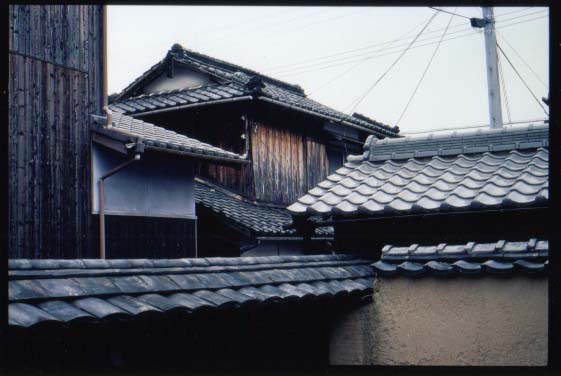 |
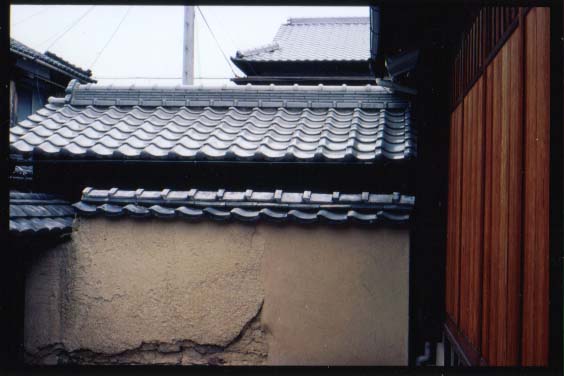 |
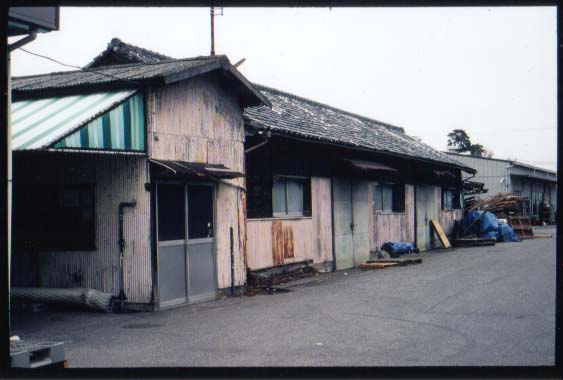 |
IHJ Artists’ Forum
In the Gardens of Japan
- Kenny Fries/Lyrics Yuka Takechi/Composition Mika Kimula/Voice Accompanied by Christopher Yohmei on the shakuhachi
- Kenny Fries/Lyrics Yuka Takechi/Composition Mika Kimula/Voice Accompanied by Christopher Yohmei on the shakuhachi
- Date: November 22, 2002 7:00 PM
Venue: The International House of Japan Lecture Hall
Poet and non fiction writer Kenny Fries, presently in Japan on the Japan-US Creative Artists’ Exchange Fellowship, will collaborate with composer Yuka Takechi and vocalist Mika Kimula in a concert of poetry set to music. “In the Gardens of Japan” will feature a series of poems inspired by several of Japan’s famous gardens. Fries describes the process of writing his impressions of Japanese gardens:
Before arriving in Japan last May, I had not written a poem in over four years. Years of writing nonfiction made the medium of poetry seem incapable of expressing as much as I wanted to express. This changed soon after I arrived in Japan. I was overwhelmed by an abundance of new cultural experiences and constantly faced with unfamiliar but emotionally encompassing sights and sounds. Among these experiences, two images began to stand out and pervade my thoughts: the irises of Meiji Jingu and the voice of singer Mika Kimula. I began spending more time in the gardens of Japan. What emerged was a sequence of poems that on the surface describe what can be found in the gardens. However, just as Japanese gardens suggest a microcosm of what it means to be alive in a mortal world, the poetry pointed to deeper meanings below the surface. I also wanted to explore how my English words might reverberate to the sounds of traditional Japanese music, especially vocal music. Could my poems become song? The idea occurred to set the poetry to music, featuring Mika’s voice. Japanese gardens take you from the entrance, lead you through various meanderings and finally return you to the beginning. Likewise, my encounters with Japan led me back to poetry that, like the gardens, hold within them an entire world.
Kenny Fries
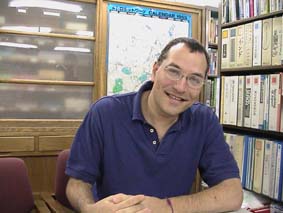 Kenny Fries is the author of Body, Remember: A Memoir (Dutton, 1997) and editor of Staring Back: The Disability Experience from the Inside Out (Plume, 1997). His books of poems include Anesthesia (The Advocado Press, 1996) and Desert Walking (The Advocado Press, 2000), as well as The Healing Notebooks (Open Books, 1990), for which he received the Gregory Kolovakos Award for AIDS Writing. He teaches in the graduate MFA in Creative Writing Program at Goddard College and lives in Northampton, Massachusetts.
Kenny Fries is the author of Body, Remember: A Memoir (Dutton, 1997) and editor of Staring Back: The Disability Experience from the Inside Out (Plume, 1997). His books of poems include Anesthesia (The Advocado Press, 1996) and Desert Walking (The Advocado Press, 2000), as well as The Healing Notebooks (Open Books, 1990), for which he received the Gregory Kolovakos Award for AIDS Writing. He teaches in the graduate MFA in Creative Writing Program at Goddard College and lives in Northampton, Massachusetts.
Mika Kimula
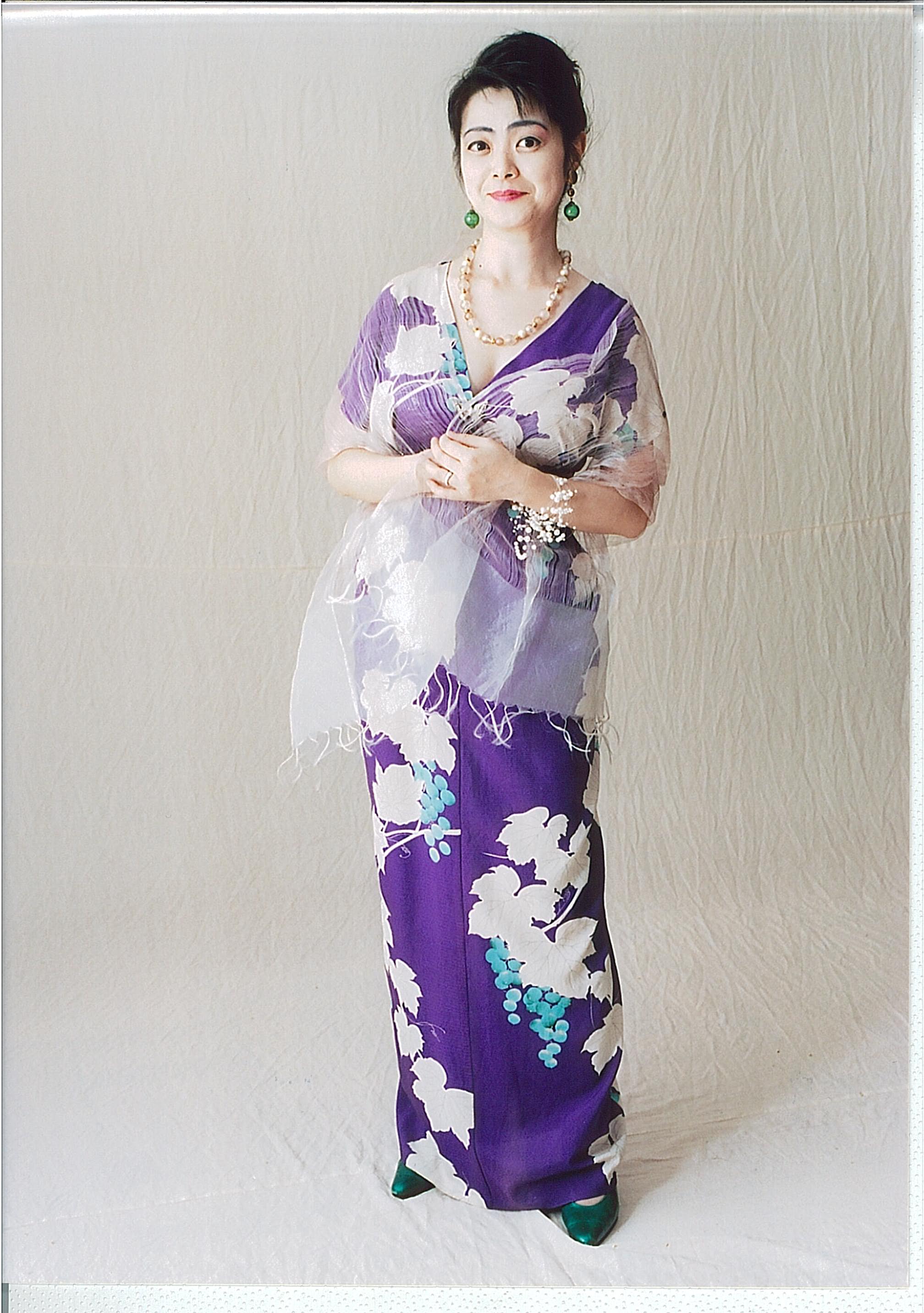 Mika Kimula, currently lecturer at Ferris Women’s College in Yokohama, is a recognized expert and performer of 20th century Japanese vocal music. Discography includes, Vocal Music in Twentieth Century Japan–The Inner Revolution between Silk and High Tech (Teichiku Records)and Bamboo Voice, Human Flute (Ongakkan). From 1997-1998,Kimula was a Fulbright Lecturer in Residence at Chatham College, Pittsburgh, Pennsylvania.
Mika Kimula, currently lecturer at Ferris Women’s College in Yokohama, is a recognized expert and performer of 20th century Japanese vocal music. Discography includes, Vocal Music in Twentieth Century Japan–The Inner Revolution between Silk and High Tech (Teichiku Records)and Bamboo Voice, Human Flute (Ongakkan). From 1997-1998,Kimula was a Fulbright Lecturer in Residence at Chatham College, Pittsburgh, Pennsylvania.
Yuka Takechi
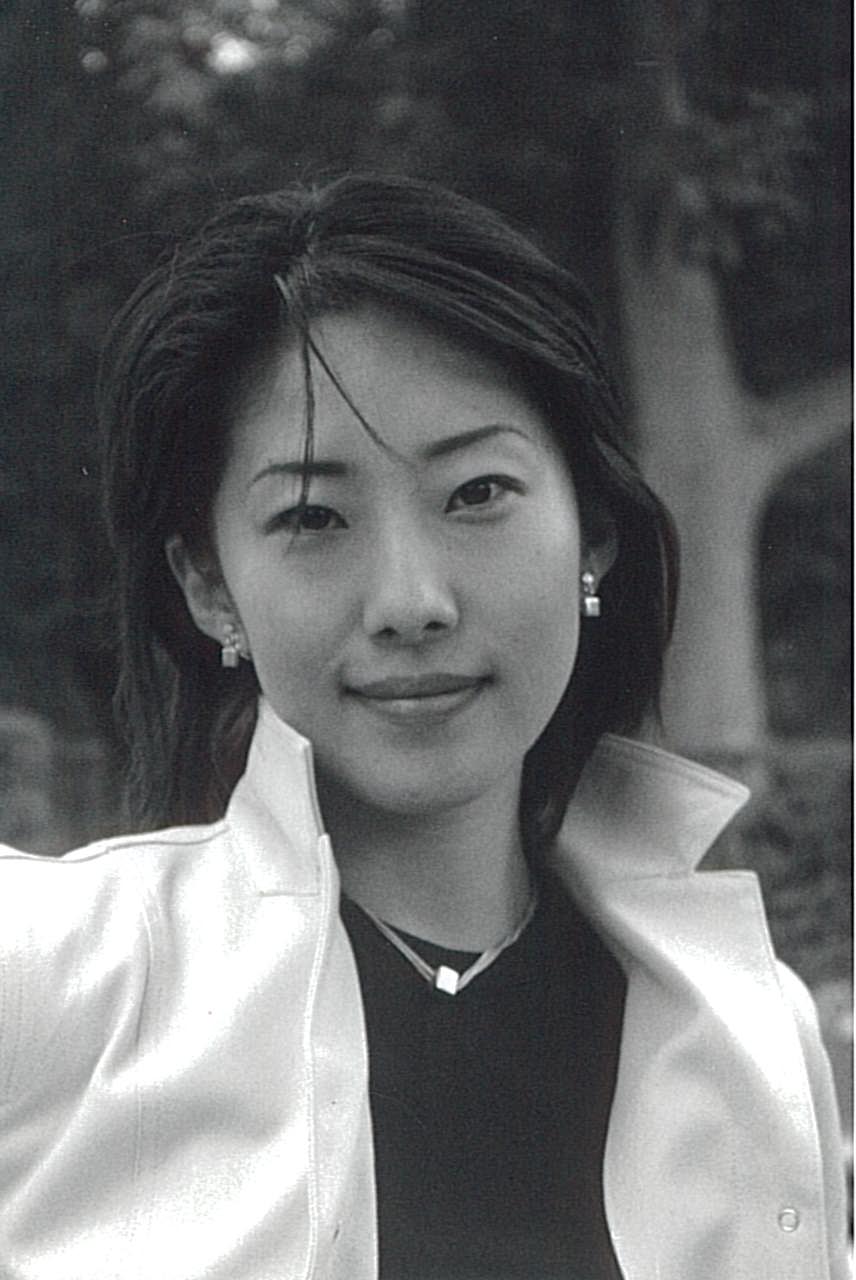 Yuka Takechi is a composer who emphasizes space and tonal qualities in her work. She graduated from the Tokyo University of Fine Arts and studied composition under Jo Kondo, Yoritsune Mastudaira and Yuji Takahashi. Her orchestral works have been critically acclaimed and performed around the world, including venues in Tokyo, Kyoto and Paris, and her works for traditional Japanese instruments performed in Japan, Croatia and France.
Yuka Takechi is a composer who emphasizes space and tonal qualities in her work. She graduated from the Tokyo University of Fine Arts and studied composition under Jo Kondo, Yoritsune Mastudaira and Yuji Takahashi. Her orchestral works have been critically acclaimed and performed around the world, including venues in Tokyo, Kyoto and Paris, and her works for traditional Japanese instruments performed in Japan, Croatia and France.
IHJ Artists’ Forum Special Installation
Translucent by Takeshi Ishiguro
- October 24 (Thu) – November 4 (Mon), 2002 The International House of Japan garden, entrance hall
The International House of Japan announces a special Artists’ Forum for the fall. Japanese artist Takeshi Ishiguro will exhibit his installation, Translucent in the IHJ garden and entrance hall. The International House of Japan was founded in 1952 to promote intellectual exchange between the US, Japan and the rest of the world. One of Tokyo’s most beautiful Japanese style gardens surrounds the I-House buildings, which were designed by collaboration of Kunio Maekawa, Junzo Yoshimura and Junzo Sakakura, well-known post war Japanese architects. The garden itself was originally created by Jihei Ogawa, who, along with Enshu Kobori, was one of the most famous garden designers of the Edo Period. For the past fifty years, the I-House has supported numerous intellectual, social and artistic exchanges with the rest of the world. In 1987, with support from the Japan-US Friendship Commission, IHJ instigated the Artists’ Forum program to encourage exchange, collaboration and communication amongst artists from Japan and abroad. Translucent consists of a site specific work placed throughout the garden and in the IHJ entrance hall. Against the backdrop of Autumn foliage, white rings of delicate smoke drift upwards toward the blue sky. The large picture window of the IHJ entrance hall frames a suspended liquid that create a giant, soap bubble-like prism. Through this translucent lens one discovers new views of the garden. The theme of Ishiguro’s installation reflects the gathering of ideas, people and impulses and the positive chemistry resulting from these exchanges. Ishiguro has worked on projects around the world and has work in the permanent collection of the Museum of Modern Art, New York. His skills include product design, stage design, and visual art. Viewing the installation is free and open to the public. Come enjoy the serenity of a traditional Japanese garden in the middle of Roppongi, and the clever, thought-provoking installation works by Ishiguro.
 |
 |
IHJ Artists’ Forum
Video and Performance
Alter Native by James Luna and Lee Wen
- May 30 (Thu), 2002 7:00 pm- IHJ Lecture Hall
- Friday, May 17th, 2002, 7:00 PM,
IHJ Lecture Hall - 7:00 PM, Sept. 25, 2001 IHJ Lecture Hall
Two performance and installations artists active in Japan, James Luna (American Indian) and Lee Wen (Singaporean) premiered their collaborative video work, “Alter Native,” an interactive dialogue about their experiences and views as “native” people living in Japan. The two artists, having met in Japan away from their ethnic and cultural origins, came to realize the need to re-examine various issues such as upholding traditional values in the face of globalization, cultural stereo-types and ethno-centric thinking. Through the video, they questioned commonly held perceptions of political and social identity and engaged in an exchange of ideas. The two artists also presented performances along with the video showing. This Collaboration event was co-sponsored by the Tokyo American Center.
James Luna
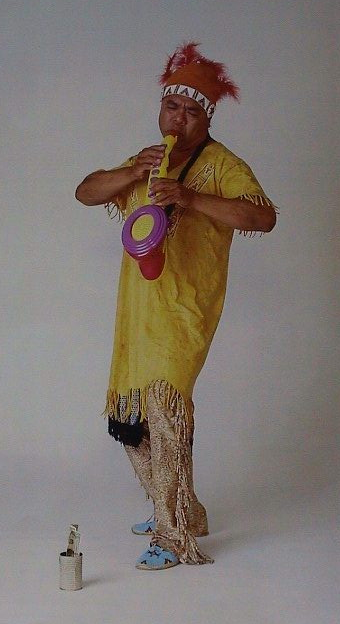 A Luiseno Indian from Southern California, James is presently in Japan on the US-Japan Creative Arts Fellowship. His artwork continually voices what it means to be an American Indian in contemporary American society and has received critical acclaim in both the mainstream art and American Indian art circles in the US and Canada. In addition to working as an artist, Luna is a full time academic counselor at Palomar Community College in San Diego, California.
A Luiseno Indian from Southern California, James is presently in Japan on the US-Japan Creative Arts Fellowship. His artwork continually voices what it means to be an American Indian in contemporary American society and has received critical acclaim in both the mainstream art and American Indian art circles in the US and Canada. In addition to working as an artist, Luna is a full time academic counselor at Palomar Community College in San Diego, California.
Lee Wen
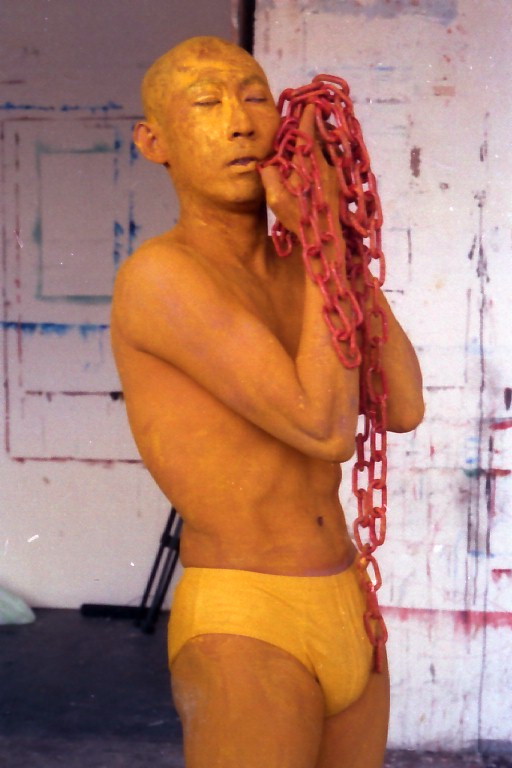 Born in Singapore and residing in Tokyo, Lee Wen exhibits and undertakes installation and performance art internationally, in alternative as well as established art spaces and events. Through the process of ‘journeying’, ‘identity’ is constructed and deconstructed, using iconic imagery; he articulates a complex and multi-layered negotiation of self-representation. By questioning relatively conservative mainstream assumptions about art and attempting to combine Southeast Asian contexts with international currents in contemporary art.
Born in Singapore and residing in Tokyo, Lee Wen exhibits and undertakes installation and performance art internationally, in alternative as well as established art spaces and events. Through the process of ‘journeying’, ‘identity’ is constructed and deconstructed, using iconic imagery; he articulates a complex and multi-layered negotiation of self-representation. By questioning relatively conservative mainstream assumptions about art and attempting to combine Southeast Asian contexts with international currents in contemporary art.
IHJ Artists’ Forum
Sam Hamill
HEART of BAMBOO
-
Poetry Reading with Musical Accompaniment
Featuring Christopher Yohmei on the shakuhachi
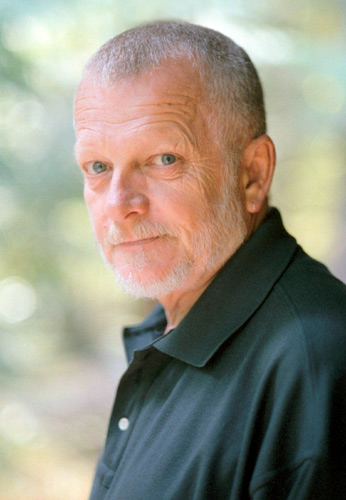 Hamill’s poem are ones of humility and thankfulness. Raised in the West and influenced by the great Chinese and Japanese masters, his poems draw from both traditions, returning us “to that world beyond words, which are only a reflection of desire.” Hamill will read his poetry in accompaniment to Christopher Yohmei Blasdel’s shakuhachi. Hamill, who came to Japan as a recipient of the US-Japan Creative Arts Fellowship in 1988, has written more than thirty volumes of poetry, three collections of essays, and translations in several languages, including many ancient Japanese and Chinese masters, from whence comes much of his inspiration and aesthetic sense. His Destination Zero: Poems, 1970-1995 (Pine Press, 1995) received a Pushcart Prize and his poetry collection, Gratitude (BOA Editions Ltd., 1998), was a finalist for the 1999 Independent Publisher Book Award in Poetry. In 2000, BOA published Hamill’s Crossing the Yellow River: Three Hundred Poems from the Chinese. He is a contributing editor for The American Poetry Review, directs the Port Townsend Writers’ Conference, and is editor at Copper Canyon Press at Port Townsend. Hamill and Blasdel will perform selections of poetry from their 1999 CD collaboration, Heart of Bamboo. This Artists’ Forum is co-sponsored by the Tokyo American Center.
Hamill’s poem are ones of humility and thankfulness. Raised in the West and influenced by the great Chinese and Japanese masters, his poems draw from both traditions, returning us “to that world beyond words, which are only a reflection of desire.” Hamill will read his poetry in accompaniment to Christopher Yohmei Blasdel’s shakuhachi. Hamill, who came to Japan as a recipient of the US-Japan Creative Arts Fellowship in 1988, has written more than thirty volumes of poetry, three collections of essays, and translations in several languages, including many ancient Japanese and Chinese masters, from whence comes much of his inspiration and aesthetic sense. His Destination Zero: Poems, 1970-1995 (Pine Press, 1995) received a Pushcart Prize and his poetry collection, Gratitude (BOA Editions Ltd., 1998), was a finalist for the 1999 Independent Publisher Book Award in Poetry. In 2000, BOA published Hamill’s Crossing the Yellow River: Three Hundred Poems from the Chinese. He is a contributing editor for The American Poetry Review, directs the Port Townsend Writers’ Conference, and is editor at Copper Canyon Press at Port Townsend. Hamill and Blasdel will perform selections of poetry from their 1999 CD collaboration, Heart of Bamboo. This Artists’ Forum is co-sponsored by the Tokyo American Center.
IHJ Artists’ Forum
Rahna Reiko Rizzuto Breaking the Silence Lecture/Reading
Rahna Reiko Rizzuto, author of the award-winning novel, Why She Left Us, will talk about breaking silences, family secrets, and her quest to recover her own family’s history by tracing the Japanese American experience during World War II. The Hawaii-born, half-Japanese Rizzuto began her career as a novelist after she found out that her own mother was interned during the war. She transformed her extensive research of the internment into a moving and universal story of family secrets and betrayals, mothers and their children, and ultimately, the need for forgiveness. Now in Hiroshima on a Japan-US Creative Artists Fellowship, she is collecting information on the years of war and occupation for her second and third novels about the Japanese American resistors and repatriates. She is also at work on a collection of letters about her experiences in and impressions of, Japan. Her talk will be followed by a reading from Why She Left Us. Reiko Rizzuto’s first novel, Why She Left Us (HarperCollins, 1999), won an American Book Award in 2000. She is also the associate editor of The NuyorAsian Anthology: Asian American Writings About New York City (Asian American Writers’ Workshop, 1999). Her essays and short stories have appeared in Mothers Who Think (Villard, 1999), The Los Angeles Times, The Asian Pacific American Journal, Many Mountains Moving: A Literary Journal of Diverse Contemporary Voices, and Salon.com. This Artists’ Forum is co-sponsored by the Tokyo American Center. Language will be English with Japanese interpretation.